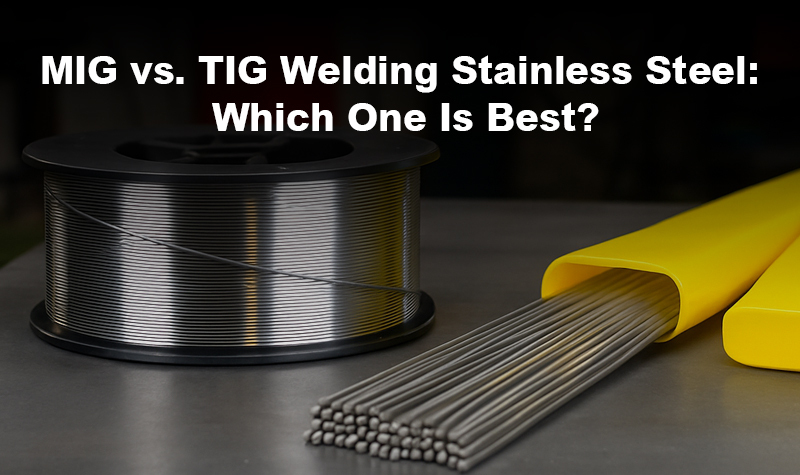Stainless steel welding appears to be the simplest thing in the world to accomplish—just heat up some metal, throw some filler in, and voila. Done, right? Wrong.
Stainless steel is an excellent material. It's shiny, it's robust, and the very best news of all, it won't rust. That's the reason why it finds itself utilised so frequently in hospitals, factories, and even art school kitchens. But to weld it? Well, you need some skill. You need to take your time, be careful, and employ the right method.
The two most common processes for welding stainless steel are MIG (Metal Inert Gas) welding and TIG (Tungsten Inert Gas) welding. Each has its optimum uses, disadvantages, and advantages.
The million-dollar question, then: MIG or TIG—Which is best to work with stainless steel?
To the point in plain and simple language.
What is MIG Welding?
MIG welding is essentially like a glue gun, but metal.
You have a gun that fires out a wire electrode from it, and you fire the trigger and the molten wire welds two metal pieces together. As you do so, a shield gas (a mixture of argon and CO₂) is released to protect the weld with impurities.
MIG tips to know:
- It's quick.
- It's simpler to learn for starters.
- It's great when welded using heavy material.
- The machine does everything for you—point and shoot.
- You'll be splattering more and likely have to clean up afterwards.
What is TIG Welding?
TIG welding is brushing and painting.
In place of a wire feed, you're using a non-consumable tungsten electrode to form the arc and manually feeding filler rod into the puddle as needed. There is a shielding gas (typically 100% argon) that surrounds the weld very much like MIG.
Things to note regarding TIG:
- It's clean and neat.
- It requires more talent and skill.
- It suits thin metal better.
- It's slower compared to MIG welding.
- It's sleek appearance and professional look.
So… Which Is Best for Stainless Steel?
That will largely be a function of your needs for your project, your level of experience, and what you are doing in stainless steel work. Let's look at some various factors to assist you in making a decision.
1. Ease of Use – Which Is Less Challenging to Master
As a novice welder, MIG is where it's at. It's half-auto, so the machine does all the work, like moving the wire forward and doing something with the arc. You just wave your hand and walk around.
TIG is more coordinated, though. Your left hand has the rod and your right hand has the torch, and generally your foot will operate a number of pedals that adjust the heat. It's like playing the drums and piano simultaneously.
Winner: MIG Welding (newbies)
2. Quality of the weld and its appearance
This is where TIG welding excels—literally. It creates welds that are neat, clean, and accurate. There's minimal spatter, and the finish never requires grinding or polishing. If you're making something to be visible, like a kitchen appliance or piece of sculpture, TIG is the way to go.
MIG welds are just as strong and usable, but go everywhere faster and spatter. You'll most likely need to redo them and clean up.
Winner: TIG Welding (when looks and precision are important)
3. Speed – Who's Faster
No argument there—MIG is. Since the wire is fed for you and you're not cutting and feeding filler yourself, MIG welding is faster and more suitable for longer welds or larger projects.
TIG is slower because it's more precise. You're moving slower, and it's taking longer to make a weld.
Winner: MIG Welding (for efficiency and speed)
4. Thin Stainless Steel
Welding thin sheets of stainless steel? You've got to be so soft you won't burn right through the metal. TIG welding gives you that sort of control where you get to see the heat and take your time.
MIG can also weld thin metal, but it's so much more difficult to heat up and warp the steel if you're not careful.
Winner: TIG Welding (when performing delicate work)
5. Best for Thick Stainless Steel
On the flip side, if you’re welding thick stainless steel, like in structural work, heavy machinery, or big repairs, MIG is often more practical. It can penetrate deeper and faster, and it saves a lot of time on larger jobs.
Champion: MIG Welding (extensive utilisation)
6. What Costs Less?
Let's discuss finances.
- MIG machines cost less than TIG machines.
- MIG is also faster, so less labour cost.
- But TIG will give you rework and cleanup time saved if you require high quality.
Therefore on basis of initial equipment cost and time saved, MIG is economical. But on basis of long term overall return for quality work, TIG can be guaranteed.
Winner: MIG Welding (on cost and speed basis)
7. What About Portability
If you must move your welding around—i.e., field use or off-site—you'll find MIG equipment more transportable, particularly the smaller setups. You can even employ multi-process equipment that does MIG, TIG, and Stick.
TIG equipment is perhaps more sophisticated with additional pieces such as foot pedals, gas regulators, and torches.
Winner: MIG (for portability)
8. Weld strength
Here's the reality: Both TIG and MIG can produce solid, sturdy welds in stainless steel. Process is half the battle.
TIG welds, if done correctly, are actually stronger with more structure and metallurgy, particularly for high-critical applications like aerospace or food-grade pipe.
MIG welds are more than sufficiently strong enough for most real-world applications—furniture making with metal, construction, or repair.
Winner: Tie (but TIG for high-integrity welds)
9. Real-Life Applications
Let's have a look at where all these processes are used on a large scale.
MIG Welding is Used on a Large Scale In:
- Construction and steel building
- Repair and manufacture of automobiles
- General metal work
- Maintenance of equipment
- Manufacturing of furniture
TIG Welding is Used on a Large Scale In:
- Aircraft and aerospace parts
- Food and drink equipment
- Works of art and sculpture
- Medical equipment and surgical instruments
- Custom motorbike and vehicle parts
- Precision piping and tubing
And where you would expect to have highest precision and cleanliness too, that is where TIG is. MIG is heavy industry workhorse of high-speed heavy-duty use.
10. Shielding Gas – Do You Need It?
Yes! The actual gas that you do use does impact the weld quality.
MIG welding will usually use a mixture of CO₂ and argon or tri-mix gas (argon, helium, and CO₂) for stainless steel.
TIG is 100% argon and provides you with a clean stable arc.
If you haven't got your gas operation running, your welds will be dirty or contaminated. So get your flow rate, your gas type, and your lines checked for leaks.
11. Good Techniques for Welding Stainless Steel
Whatever you do, these are some good techniques to help you get excellent results:
- Shut it down: Oil, rust, and grime will destroy the entire unit. Drain out all elements before welding.
- Use the right filler: Select your filler rod or wire to the same stainless steel grade that you're welding (i.e., ER308L for 304 stainless steel).
- Control your heat: Excessive heat will distort your metal or destroy corrosion resistance.
- Don't cross-contaminate: Never touch carbon steel with stainless steel brushes or tools. It'll rust it later.
- Post-weld treatment: Depending on your application, you may need to pickle, passivate, or polish your welds.
12. The Final Showdown: Which Should You Choose?
Let’s wrap it all up.
| Situation | Go With... |
|---|---|
| You're a beginner | MIG |
| You need a clean, pretty weld | TIG |
| You're welding thick steel | MIG |
| You're welding thin steel | TIG |
| You care about speed | MIG |
| You care about precision | TIG |
| You’re on a tight budget | MIG |
| You’re working on food-grade gear | TIG |
| You want fewer post-weld steps | TIG |
Is one better? The answer is—it depends.
- For quick, hard, and cheap stainless steel welding, MIG is better.
- For beautiful, precise, and pricey welds, particularly on thin metal, TIG is better.
Both processes are found in most fabrication shops, depending on the task. Experts make the choice based on what is to be done.
Conclusion
It's art and science to join stainless steel. TIG or MIG, don't care what you do depending on what you are producing, how long it takes to produce it, the mood one is in, and what the final product has to be.
If you are a newcomer, MIG will get you there sooner with a more gradual slope. But if you have to be perfect and finish perfectly, then TIG is your ticket—once you've learned it.
Having trouble selecting the welding material or equipment to employ? Don't be afraid to ask a welding expert or supplier. And, finally, patience and practice are your best friends no matter what technique you might employ.
Also Read: What is Flux Core Welding Wire and Its Types

